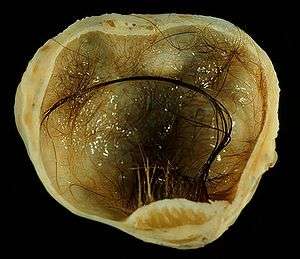Ovarian tumor
Ovarian tumors, or ovarian neoplasms, are tumors arising from the ovary. They can benign or malignant (ovarian cancer).
Benign tumors
Further information: Ovarian cyst
Benign tumors of the ovary include ovarian cysts, such as borderline tumor cysts.
Cancer
A pathological specimen of ovarian carcinoma.
Main article: Ovarian cancer
Ovarian cancer is classified according to the histology of the tumor, obtained in a pathology report. Histology dictates many aspects of clinical treatment, management, and prognosis.
- Surface epithelial-stromal tumours, also known as ovarian epithelial tumors, are the most common type of ovarian cancer. It includes serous tumour, endometrioid tumor, and mucinous tumour. They can be benign (cystadenoma) or malignant (cystadenocarcinoma). Less common tumors are malignant Brenner tumor and transitional cell carcinoma of the ovary.
- Sex cord-stromal tumor, including estrogen-producing granulosa cell tumor and virilizing Sertoli-Leydig cell tumor or arrhenoblastoma, accounts for 8% of ovarian cancers.
- Germ cell tumor accounts for approximately 30% of ovarian tumors but only 5% of ovarian cancers, because most germ cell tumors are teratomas and most teratomas are benign. Germ cell tumors tend to occur in young women (20's-30's) and girls. Whilst overall the prognosis of germ cell tumors tend to be favourable, it can vary substantially with specific histology: for instance, the prognosis of the most common germ cell tumor (dysgerminomas) tends to be good, whilst the second most common (endodermal sinus tumor) tends to have a poor prognosis. In addition, the cancer markers used vary with tumor type: choriocarcinomas are monitored with beta-HCG; dysgerminomas with LDH; and endodermal sinus tumors with alpha-fetoprotein.
- Mixed tumors, containing elements of more than one of the above classes of tumor histology.
| ||||||||||||||||||||||||||||||||||||||||||||||||||||||||||||||
This article is issued from Wikipedia - version of the 12/21/2015. The text is available under the Creative Commons Attribution/Share Alike but additional terms may apply for the media files.
